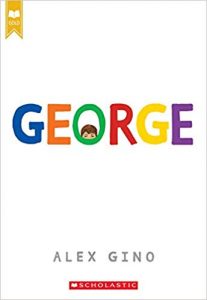
In most ways, Melissa is a typical fourth-grade girl: she likes to wear pink, she cries when upset, she has a BFF, and she loves Charlotte’s Web. She loves the character of Charlotte so much that she’s devastated when she is rejected for the part in her school’s play, even though in the audition she read the part with more depth of feeling than any of the other girls. Her teacher even reprimanded her for reading the part, saying she can’t possibly be cast as Charlotte when there are so many girls that want the role.
Because, you see, Melissa is also George. That’s the name her parent gave their biologically boy baby, and that’s the name her teachers and classmates know her by. Only Melissa knows she’s really a girl, and her struggle to claim her identity as a girl is the story told with empathy and compassion in George, by Alex Gino.
I picked George out of the American Library Association’s list of the ten most challenged books in 2017, to read for this year’s Banned Books Week. It’s easy to see why it upsets some people; the idea that gender identity does not always align with a person’s biologically assigned sex is one that our society as a whole is just beginning to grapple with. Does that make it inappropriate for preteens? Not in my opinion. Better, in fact, that the preteens who do not have gender identity issues should be introduced to the idea that others might before puberty’s raging hormones kick in.
And as for the children that are transgender people? They’re the ones who need it the most, to know that they’re not alone, that they do have options, and that there are people who will support them in their choices. Many transgender people are aware of the discrepancies between their assigned sex and perceived gender from an early age. The discrimination transgender people face is huge; no one proclaims they are one on a whim. It just seems silly to worry that a story like George would make little boys who aren’t already experiencing gender dysphoria decide they must be girls, or vice versa.
Nor do I expect most children will get more than momentarily confused by the pronoun usage in George. They’re more likely to adapt and get on with the story than the adults whose preconceptions have hardened.
Is George a great book? No. The prose is mostly OK, neither outstandingly good nor bad. Some of the action and dialog seems a bit off-kilter or too old for the characters, it’s a little slow, and the acceptance Melissa gets when she confesses to her best friend is too immediate to feel real. On the quality of the writing alone, I’d call it average: three stars. I also found Melissa’s absorption in stereotypical female behaviour a bit off-putting. (As a woman who dresses in jeans, usually forgets to apply makeup, and was the first girl in my high school to take machine shop, I wonder just what it is that makes a woman a woman. But not having experienced gender dysphoria, I have to accept that the author, who has, is speaking from experience, and that experience is valid for some transgender people.)
Are George and the few other books like it necessary? Yes. The good work they do in encouraging open minds and empathy is priceless. George may save someone’s life someday. Five stars.
Audience: Preteens, or anyone struggling to understand transgender people.

No, sorry, I don’t do twitter, but you can sign up to get email whenever I post something new on the blog.
I like your blog. It looks pretty informative. I will share this with my brother.
Thank you!